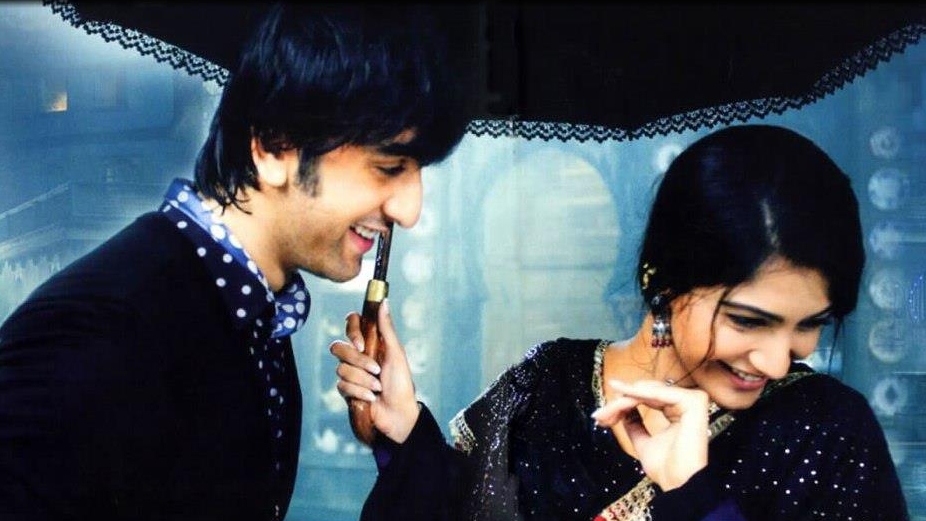“When someone reads a book, I will miss you. When someone sneezes, I will miss you. When someone laughs while he cries and cries while he laughs, I will miss you.”
2007. 138 minutes. Rated PG.
I am not at all up on my Russian authors. I didn’t know what a palanquin was until I Googled it. I’ve only seen two other Bollywood movies–Monsoon Wedding and Bride and Prejudice (“Slumdog Millionaire doesn’t count,” says my friend Dan, not unkindly). Still, I found Saawariya completely enchanting.

Singing in the Rain, Bollywood style
I’m a sucker for love stories, and I love musical theatricality; Saawariya features both. There are a ten songs (11 if you count the reprise) to set the tone and further the plot, which follows Fydor Dostoevsky’s short story of unrequited love, White Nights. The film features several musical tropes, including a (male) tenor ingenue, dancing like you’re fighting, no song for the villain, and multiple summonings of backup dancers who just happen to know the choreography.
Narrated by Gulabji (Rani Mukeji), a jaded lady of the night, Saawariya tells the story of Ranbir Raj’s (Ranbir Kapoor) arrival in town. A talented young musician with a Beatles haircut and the moves of young Elvis (with a little Michael Jackson thrown in), Raj’s first number (“Saawariya”) is both an “I want” and am “I am” song that declares his desire to be beloved and be loved. Hired on as the new lead singer at the RK Bar in the red light district, he opts to live amongst the whores, being kind to those who are someone else’s mothers, sisters, or daughters. They at first laugh at him, then are touched, and he wins them over one at a time, never asking anything in return but their smiles. Gulabji becomes a friend and confidant, and perhaps falls a little bit for Raj, herself.
On the eve of Eid (a major holiday in Muslim countries, celebrating sacrifice), Raj meets a quiet stranger in a dark alley and it’s love at first sight. Raj serenades Sakina (Sonam Kapoor) with “Masha-Allah” (translated to Gosh, so beautiful, though the real meaning is, by the grace of God) in s sweet, bashful way that is completely endearing. Kapoor plays Raj with an earnestness that isn’t familiar in American films; it’s a nice counterpoint to the timidity and naivete of the character in White Nights.
Over a handful of evenings, Raj falls in love, writing Sakina’s name on the walls all over town, but Sakina reveals she has awaited the return of her lover Imaan (Salman Khan) over the past year; he has promised to return at Eid. She and Raj must remain only friends. To add insult to injury, just as he is about to proclaim his feelings, she mistakes the writing on the wall as a sign of Imaan’s return. He proposes, but she doesn’t take him seriously. At least he gets to keep the umbrella.
Humor balances out the pathos, ranging from wordplay to physical jokes: shopkeepers turn off their lights, as Raj approaches them one by one in an attempt to escape his shame at Sakina’s teasing. Raj’s cantakerous landlady Lillian’ (Zohra Sehgal) steals every scene she is in, whether she is griping at Raj, missing her son, or singing off-key.
Comparisons to Baz Lurhmann’s work are not far off: stunning stage-like sets, gorgeous traditional costume, and synchronized dance numbers. The lighting is particularly fantastic; the scenes are all set at night, and yet lit like it’s a full moon, in beautiful blues accented with purple and gold streetlamps and bulbs. The soundtrack is lush–lots of strings, and captivating drum rhythms. Great attention is given to visual cues, as well: waterlilies abound, representing life, fertility, divinity and enlightenment. A ticking clock is ever present in the background. And ever so eloquently, Raj’s disappointment is set to rainfall.
I grew up in a town that is still 90% white, and chose a college that prided itself on it’s multicultural diversity. I’d like to think I’m educated and not culturally illiterate, but I am embarrassed to say that I was surprised to find so much English in the film. How would native Hindi speakers get the signage and the smattering of English throughout? Then I remembered that although speaking only one language is the norm here in the States, it’s not unusual in many other parts of the world to be be fluent–FLUENT–in 3, 4 or even 5 languages.
I felt sort of naive for being surprised, and disappointed to not be able to appreciate all the nuances. I was lucky to see the first half of the film with friends Meena (who is fluent in Hinda and shared the inside jokes and cultural connotations that went over this white girl’s head) and Dan, who is well-schooled in Bollywood films and could speak to the things that made this first Indian film to be released by a North American distributor a success, including such international appeals as giving the male lead his own provocative (and scantily clad) item number.
This is a great, entry-level film for anyone interested in exploring Bollywood movies.
